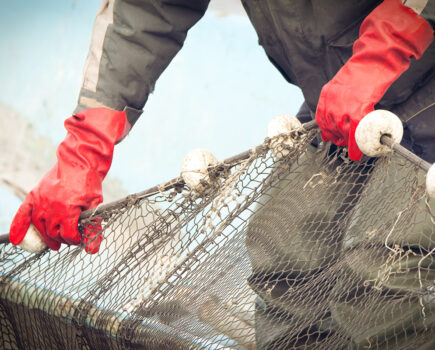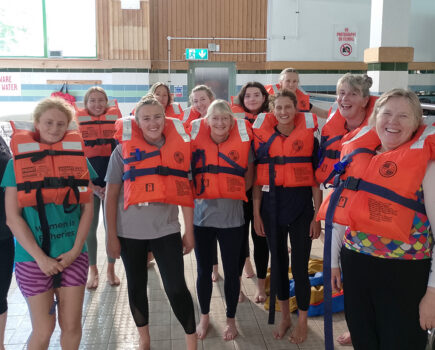Andy Read completes his report from his recent visit to Shetland – starting with a discussion about the challenges and opportunities for the local fleet with the SFA team
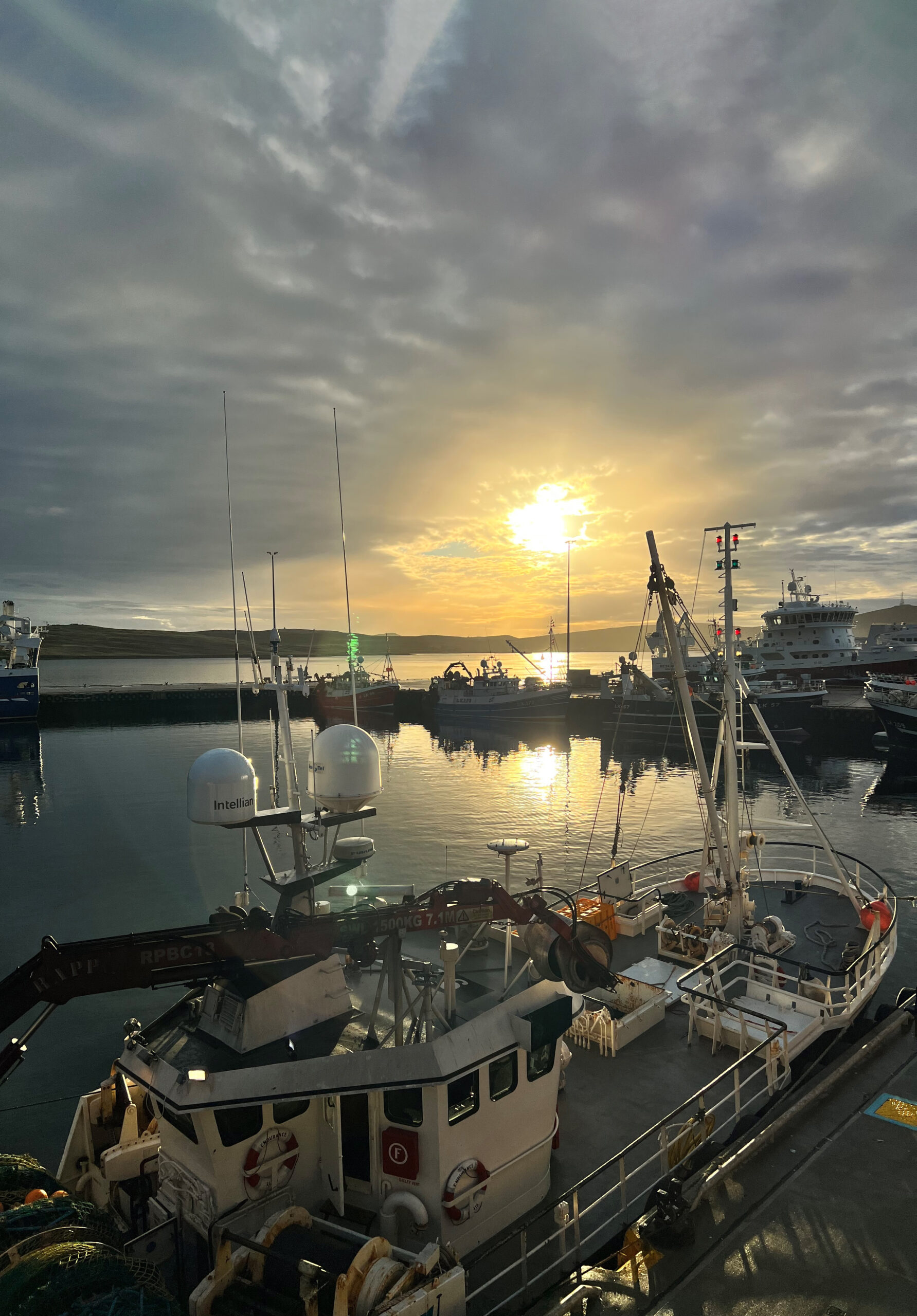
A new dawn in Shetland: the view from the SFA office, photographed at 8.45am on 11 October. Endurance LK 416 is in the foreground, with Brighter Hope LK 98, Mizpah LK 173, Alison Kay LK 57 and Opportune LK 209 berthed inside the pier, and Research LK 62 berthed on the outside. (Photo: Una Simpson, part of the SFA team, who failed to make the picture on the right!)
When I talked with Sheila Keith, and later met with the rest of the team at the Shetland Fishermen’s Association (SFA), they were keen to emphasise the symbiotic relationship that exists between the association and the Shetland FPO, collectively known as Shetland Fishermen.
The two organisations, along with the Shetland Shellfish Management Organisation (SSMO), share offices above the new Lerwick fishmarket.
She explained how the SFA team had grown, and is currently considering how best to deal with the expanding workload covering the pelagic, whitefish and inshore fishing sectors.
“This is a work in progress. Being the voice of Shetland fishermen is a privilege, but a huge challenge. Rest assured that we are all working as a team, to maximise the benefits of what we are doing on behalf of Shetland fishermen.
“SFA has 115 vessels in membership, including the entire pelagic and whitefish fleets as well as the majority of inshore fishermen targeting both shellfish and finfish. We collaborate very closely, as well, with the SSMO, which does also have some boats in membership that aren’t under the SFA umbrella.”
The concerns Shetland fishermen have often mirror those of fishermen in the rest of the UK, but the Shetland Fishermen team also has a range of responsibilities that are wider than those of many representative organisations. Recognising that fishing is the backbone of the island community, the Shetland Fishermen remit often goes beyond just catching.
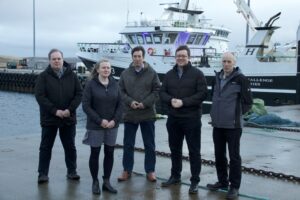
Some of the SFA team and colleagues. Left to right: Brian Isbister, Sheila Keith, Simon Collins, Daniel Lawson, and John Robertson of the SSMO. (Photo: Peter Johnson)
Shetland Fishermen is involved in marketing, for example, through involvement with Pelagia Shetland and the development of the local seafood provenance scheme. As part of the Market Users Management Team, the SFA helps ensure that market users comply with HACCP rules and maintain best quality on each and every market.
Sheila explained: “Our proximity to the grounds, and utter reliance on healthy fish stocks, also means that maintaining sustainability is a priority, utilising the scientists at UHI Shetland to gain the best understanding of stocks, whether that be through industry science onboard pelagic vessels, measuring catch per unit effort for species such as monkfish, or the annual inshore stock survey for finfish.
“This becomes all the more important as we see Marine Scotland shift resources into the offshore energy sector, at the perceived expense of fisheries science and monitoring. The cuts to Marine Scotland’s budgets make it harder for them to meet the needs of the industry, to ensure sustainability and reduce reputational risk. It is hoped that there is a willingness for government to work collaboratively with the fishing industry to fill the gaps.
“This makes the headlong rush into wind power doubly worrying for us. Not only are we seeing a real risk of loss of access to some of the most productive fishing grounds in the world, we are seeing at the same time reduced resources to assess the stocks, and monitor the cumulative impacts of so many offshore developments being put in place in a very short space of time.
“We very much see ourselves as custodians of these fish stocks, without which our communities wouldn’t be viable, which is why we are putting so many resources into helping with their assessment and protection.
“We very much think that renewable energy – the principle of which we strongly support – should be a win-win for Shetland and Scotland. This needs a genuine two-way dialogue, an acknowledgement that certain fishing grounds are a no-go for future development, and an honest partnership between sectors.
“At the moment, we are finding ourselves constantly having to react to proposals, within fishing grounds that should have been an automatic constraint to developments due to impacts on fishing. We often see a precautionary approach applied when looking at fish stocks, and question why the same approach is not taken when dealing with offshore wind and their associated cables.”
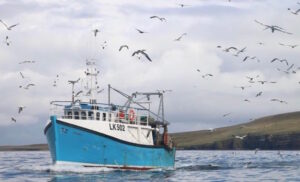
The University of the Highlands and Islands (UHI) research vessel Atlantia II LK 502, which is also a registered fishing vessel. UHI works closely with the SFA and other fishermen’s organisations in Shetland to help to underpin stock management with sound science. (Photo: Ian Leask)
For a group as progressive as the SFA, which has been at the forefront of pushing for the best possible science and conservation measures, and with a demonstrable track record of engaging in genuine co-management, the relationship with green NGOs and Scottish Greens has also become a growing frustration, Sheila said.
“The SFA and many green groups have so much in common. We should be pulling together, but instead we see out-of-town green groups pushing falsehoods for a cheap headline, with little interest in genuine dialogue. Shetland has done so much with regards to ensuring we have sustainable fisheries, but continues to be unsupported for our efforts.
“On issues such as the high levels of intensive gill-netting we are seeing here, we are getting little traction towards change. We await the results of a consultation which we hope will see introduction of a one-for-one swap policy when taking delivery of new gill-nets.
“We are pressing hard for introduction of a code on maximum soak times, and agreements on deployment of the gear that doesn’t see our fleet pushed off traditional grounds.
“Ending on a positive note – which we should, of course – the impacts of HPMAs and offshore energy on the Shetland fleet would be a complete catastrophe if it was set against a backdrop of poor stocks. However, the abundance of fish seen in the waters around Shetland is positive, indicating that stocks are in great shape.
“Work continues to ensure science better represents the true stock levels, good or bad, and we look forward to joining our North Atlantic counterparts at the Cod Symposium being held in early November in Edinburgh. We hope to see more realistic TACs in 2023 and the future.
“We have a young, enthusiastic fleet, and genuine involvement across the sector into the heart of politicians and government, to ensure we all work together for the common good.
“Shetland relies on fisheries to an extent seen almost nowhere else. So long as SFA can play its part in ensuring that stocks remain as healthy as they are now, and our members continue to be fully involved in their co-management, our members, and their communities, have a great future.
This story was taken from the latest issue of Fishing News. For more up-to-date and in-depth reports on the UK and Irish commercial fishing sector, subscribe to Fishing News here or buy the latest single issue for just £3.30 here.





